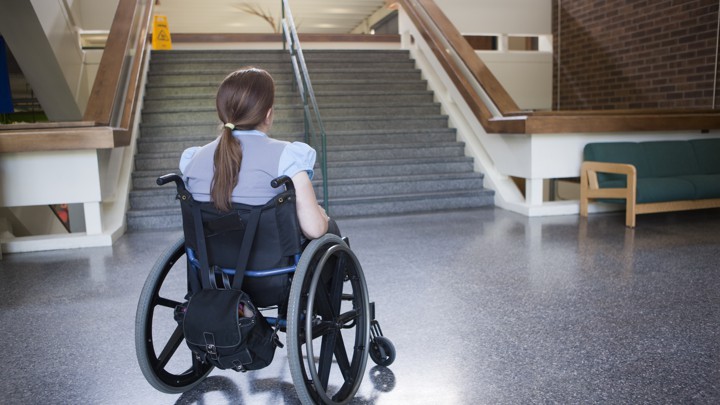The Panopticon
![]()
Jeremy Bentham was an English social theorist and philosopher in the late 18th century. He was an advocate for legal and social reform, and one of his ideas to do was to build a prison building, called “The Panopticon.” For this building it consists of a circular structure with an “inspection house” at its center. In this house was a manager or staff and a bright light who would be able to watch the inmates. The inmates were to be stationed around the perimeter of the structure in cells. This allowed the watchman to observe the inmates without the inmates knowing whether or not they are being watched. Consequently, the inmates have to assume they are constantly being watched. This can be related to modern times in terms of surveillance, either with cameras, our smartphones, or the Internet of Things. With surveillance cameras, the lens is so dark that most of the time we are unsure if it is working, or if it is pointing to use. Therefore, we assume that it is on and behave accordingly. Similarly with our smartphones our data is constantly under surveillance by the government and corporations. The internet of things plays a role in this as well. Many of these technological devices have unsafe software that can be easily hacked or spied on. This means that we can be watched without our knowledge, just like how the inmates in the panopticon might have felt.
https://www.theguardian.com/technology/2015/jul/23/panopticon-digital-surveillance-jeremy-bentham

Modelo Presido in 1995 in Cuba
(built in 1920s, now abandoned)
Hannah Arendt
Hannah Arendt was a German political theorist and philosopher. During her life she researched antisemitic propaganda which led to her imprisonment by the Gestapo. After she was released, she fled Germany and began assisting young Jews to move to Palestine. As she was living in Paris, she was detained by the French as an alien but eventually escaped. She then moved to the United States where she lived the rest of her life in New York. She became a writer and is most famous for her book “The Origins of Totalitarianism”. It was a critical analysis of the political movements that led to World War I/II and the death camps. She faced much criticism for her book “Eichmann in Jerusalem”. The book was based on the trial of Eichmann, where she described him as a thoughtless bureaucrat rather than evil. Many people saw this as a lack of sympathy and respect for the victims and survivors of the Holocaust.
Jordan McIntosh
See How This Artificial Intelligence Reproduces Paintings
New artificial intelligence technology is capable of restoring and even reproducing famous pieces of art. RePaint, made by a team from MIT’s Computer Science and Artificial Intelligence Laboratory, is a combination of artificial intelligence and 3D printing in hopes of reproducing famous paintings. Mike Foshey, a mechanical engineer at the laboratory, said that this technology can be “applied with restoration practice and education in museums so that greater numbers of people could be exposed to famous pieces of art beyond just the specific museums that house them.” This is concerning because it takes the human emotion out of art.
Ryan Alvarado
Your Face Is Now Your Boarding Pass

New technology has allowed face scans to replace physical boarding passes and passports for travelers flying to select international destinations out of Atlanta’s Hartsfield-Jackson International Airport. Now travelers will be able to use this biometric system to check baggage and board their flight. Although many are concerned about the how secure and accurate this new technology will be, the majority see’s this advancement as even safer and more convenient than using actual boarding passes/passports.
Derin Uluc
On Demand Eyes for the Blind

Named one of times 50 best inventions of 2018, this device gives the blind a new lease on life. This allows the blind to have assistance doing everyday things by wearing these glasses or using an app and someone telling them where things are. This allows those who are blind to do things that would normally be very challenging in a faster and easier way. On-demand agents are behind the screen assisting them 24/7.
Savannah Stallings
Wanted: The ‘perfect babysitter.’ Must pass AI scan for respect and attitude.

An online service that uses “advanced artificial intelligence” to assess a babysitter’s personality, and aimed its scanners at one candidate’s thousands of Facebook, Twitter and Instagram posts. The system offered an automated “risk rating” of the 24-year-old woman, saying she was at a “very low risk” of being a drug abuser. But it gave a slightly higher risk assessment — a 2 out of 5 — for bullying, harassment, being “disrespectful” and having a “bad attitude.” The system didn’t explain why it had made that decision.
Liam Short
20 Americans die each day waiting for organs. Can pigs save them?

20 Americans die each day, waiting for organ transplants. Even though 58% of adults in the United States are organ donors, the demand for organs is more than the supply. However, with developments in xenotransplantation technology, it might soon be possible to grow organs inside specially engineered pigs, to use in organ transplant surgery. The biggest hurdle is that humans have antibodies that protect us from the aplha-gal enzyme, which is found in pigs’ immune systems. This is what causes the majority of rejection from using pig organs in humans. Using Crispr, scientists were able to develop pigs that could possibly replace human organs. The first clinical trials are happening next month in Boston.
Navin Rai
Scientists design an office chair that cancels noise
Certain types of low frequency sounds can be distracting at work. This office chair may make open offices and work spaces with constant white noise a little more bearable. a survey by a research firm showed that workers in an open office can lose up to 86 minutes of productivity per day due to distractions, like the constant humming of machinery or computers. In this scenario, noise-cancelling headphones have emerged as an important tool for people working in open office environments. However, it is physically uncomfortable to wear such headphones for long hours. To enhance sound privacy while ensuring comfort, scientists at the Budapest University of Technology and Economics have designed an office chairthat can control not only tonal noise like humming machines, but also broadband (random) disturbances coming from anywhere in a room.
Nathalie Nava
Meet Zora, the Robot Caregiver

This is an experiment in France where this robot, Zora, “takes care of elderly patients.” Zora does not actually perform medical acts or surgery, but is there for emotional support and companionship. Zora is used to overcome the loneliness of elders and can cost up to $18,000 and is controlled through a computer by a nurse. The nurse will type sentences and Zora will speak to the patients. “It is part of a growing emphasis on robotics focused on care.” There are getting to be more elderly people and not enough humans for healthcare jobs.
Ryan Sprosty
The Bumps Ahead for Autonomous Vehicles

Companies all across the world are trying to be the first to produce an autonomous car for the mass market. The three most common sensors found on autonomous cars are lidar, radar, and cameras. However, objects found on the road that humans can perceive as harmless can confuse these sensors. For example, the curved bottom of a soda can could incorrectly amplify radio waves that bounce off it, making it appear a much larger object to the sensor. This could cause the car to break or swerve unnecessarily. Another issue would be to make the sensors more resistant to harsh weather conditions such as snow or rain. While driverless cars may be on the horizon, there is still a long way to go before they are safe for the road.
Jared Osmond
Electronic Monitoring as an Alternative to Prison
In America, electronic monitoring is used during parole or probation, however across Europe and in South America, it is becoming more popular to use it as a substitute for prison as a whole. For those convicted of nonviolent or low grade crimes, This system allows convicts to live at home with their families and go towork, which helps significantly with financial, economical, and relationship problems that can come with being sent to prison. An alarm sounds when they cross a boundary or break their set schedule, police officers do random checks to be sure they are staying on schedule and are where they should be, and they are subject to random drug and alcohol tests. This system is also saving taxpayer money that was going to the expensive costs of prison, and it is lowering the percentage of criminals who reoffend from almost half to just 17%.
https://www.economist.com/technology-quarterly/2018/06/02/electronic-monitoring-is-a-different-approach-to-jail
Makenna Mumford
A Smart City Is an Accessible City
Accessibility Apps are turning cities into “smart cities”. These accessibility apps allow people with different disabilities to easily locate restaurants, cafes, and shops that have been determined disability welcoming. The app documents these places on maps and rates their features. Since the app is dependent on crowdsourcing, the results can be inaccurate. For instance, someone might rate a bathroom “accessible” if there are no stairs. However, they do not take into account such things as sink and hand dryer heights that may be out of reach to those in wheelchairs, ultimately causing the bathroom to be inaccessible.
Jordan McIntosh
In China, Bill Gates Encourages the World to Build a Better Toilet

Bill Gates, founder of Microsoft, is attempting to find a better solution of the use of toilets. His idea is to improve the toilets for the improvement of hygiene and that don’t have to connect to water systems. There are many countries around the world that do not have safe sanitation and access the water. His goal are for these toilets to be able to break down the human waste and use it as a fertilizer along with other beneficial outcomes. The only downside in this project is the time for research and the amount of money that will be put into this process. Once these toilets are improved it will still take some time for them to reach certain countries.
Luisa Macias
Making Trains Run on Time

Plamen Angelov of the University of Lancaster, in Britain has developed an idea that he hopes will make train delays rarer and increase safety. The problem isn’t the inefficiency of operators but the behavior of passengers to use railway parlance. He believes that applying artificial intelligent to the problem might help. The goal is to use images from CCTV cameras already mounted in carriages and on platforms to measure the movements and positions of individuals relative to areas such as train doors or safety lines to predict problems and increase safety. A new software will inform passengers to enter doors that appear to be less busy decreasing the chance of having to open doors for people to enter which in turn delays departure. Although this seems like it can benefit society, cameras can be hacked into which may cause more harm to passengers boarding and exiting the train and lead to more severe accidents.
Annette Le
Google Glass is Back – Now with Artificial Intelligence

Google Glass is making a return to the markets, but this time it is accompanied by a new app created by software company Plataine. The app was built using AI services and is working to add image and voice recognition to the device. Google Glass provides an eye-level camera and display, and will now have similar functions to Amazon’s Alexa. The company states that the app combined with Google Glass could be helpful in the workplace, because employers could instantly see each of their employees’ actions. This, however, raises some privacy concerns not only within the workplace, but also in the event that someone were to hack into the system. After all, Google Glass had already been launched years before but was quickly removed from the markets due to similar privacy concerns.
Jessica Lundstrom
Red Hydrogen One holographic phone has potential, but it’s far from ready

There’s a new phone that recently came out called the RED Hyrdogen One, which claims to have holographic picture capability, that can turn pictures into 3D views, which they call “4V”. However, the result is pretty pathetic, and the pictures only slightly are 3D, and can only be seen as 3D on these specific phones. This questions whether new technology is really necessary, as these phones are almost $1,300 and likely a bust in the market.
Jake Larson
Researchers: Vein authentication can be deceived

More and more technology such as ATMs and smartphones use veins as a means of authentication. This type of authentication is very secure, however a team of researchers has managed to deceive the sensor by using regular digital cameras. They took pictures of the individuals’ fingers and recreated their vein patterns with image processing. By using this method the sensor was tricked more than half of the time. Even though the process is quite hard to do, it still posses a potential privacy risk to individuals. If someone manages to recreate a person’s vein pattern or steal their bio-metric information they would have access to a plethora of things.
-Eddy Flores
The Robot Revolution Is Coming, and Dang Is It Cute
Robot toys area becoming more advanced and capable of being a part of our daily lives. These toys can have pixelated faces that makes them feel more alive, and cameras so they can operate around the house. They are capable of roaming your house on their own and learn the layout of your house. They can even play games with you to give you entertainment. Although they aren’t completely mastered yet, it is still very impressive what they can do.
-Alexander Churness
Your Kid’s Apps are Crammed with Ads

With there being more and more educational apps directed towards young children five and under, Jenny Radesky, a pediatrician, wanted to check them out. She found that by looking at the most downloaded games that 95% of them had at least one type of advertising. These advertisements, sometimes disturbing imagery, were ones that would send the children into another ad or video on a seemingly endless loop or were ads that were unreasonable to assume a child would be able to close out of. One of the consistencies within the research about these types of apps is that by having many distractions, such as these ads, the children don’t absorb the underlying message as well. The practice of gently pressuring children to make purchases was banned by the Federal Trade Commission, and Radesky and others are trying to have them investigate these advertisements. She hopes that this study will have parents ask more questions about what their children are playing as well as the harder task of having the FTC create more regulations.
-Noor Fahmy
Fast Food via Drones

With the rise of drones, Maron Kristófersson is excited to implement his idea of delivering food with drones. However, he does not want to stop there. He believes that he could also deliver medical supplies to country in need. In August 2017, Maron Kristófersson teamed up with the Israeli drone service, Flytrex, and they persuaded Iceland’s transportation authorities to allow them to begin drone delivery. These drones can carry goods up to 3kg in weight, and when weather permitted, the drones proved to be more efficient in delivering food items. This test-run in Iceland proved effective and cost-efficient. Services like Uber are now looking into drones for food delivery. However, there are some unforeseen consequences that come with drone-delivery. For example, surveillance of the drones is very unexpected, meaning that it can record people without them knowing. Additionally, finding places for drones to hover is very difficult. Finally, there are the possibilities of crashes, or people trying to hit the drones with various objects. This can cause damage and injuries. Overall, although drone delivery seems like a fun and efficient idea for delivering items, the downfalls outweigh the good.
-Emma Bose
https://www.economist.com/science-and-technology/2018/10/23/fast-food-via-drone-takes-flight
Lime blamed its fire-prone batteries on Segway’s manufacturing. Now Segway is pushing back (Washington Post)

Lime scooters are a significant technological advancement in the transportation realm of the world. They are a great concept until they recently found some could be more harmful than beneficial with some batteries being prone to catching on fire, due to a welding issue (as Lime claims). The manufacture of the battery states the real cause could be due to lack of charging, or overcharging, and the amount of crashes they are subject to. The concern relies on only the scooters of Lime, so far other companies like Bird, have not had any of the same effects, yet use the same scooter manufacture.
-Mina McCormick


